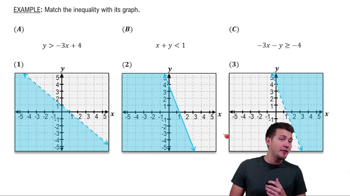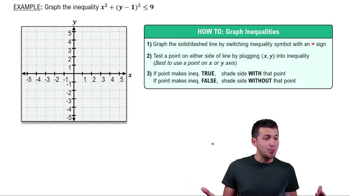Table of contents
- 0. Review of Algebra4h 16m
- 1. Equations & Inequalities3h 18m
- 2. Graphs of Equations43m
- 3. Functions2h 17m
- 4. Polynomial Functions1h 44m
- 5. Rational Functions1h 23m
- 6. Exponential & Logarithmic Functions2h 28m
- 7. Systems of Equations & Matrices4h 6m
- 8. Conic Sections2h 23m
- 9. Sequences, Series, & Induction1h 19m
- 10. Combinatorics & Probability1h 45m
7. Systems of Equations & Matrices
Graphing Systems of Inequalities
Problem 27a
Textbook Question
Graph each inequality. y > 2^x + 1
 Verified step by step guidance
Verified step by step guidance1
Step 1: Start by graphing the boundary line of the inequality, which is the equation \( y = 2^x + 1 \). This is an exponential function that shifts the basic graph of \( y = 2^x \) up by 1 unit.
Step 2: Since the inequality is \( y > 2^x + 1 \), the boundary line should be dashed to indicate that points on the line are not included in the solution set.
Step 3: Choose a test point that is not on the boundary line to determine which side of the line to shade. A common test point is the origin (0,0), unless it lies on the boundary line.
Step 4: Substitute the test point into the inequality. If the inequality holds true, shade the region containing the test point. If not, shade the opposite side.
Step 5: The shaded region represents all the points \( (x, y) \) that satisfy the inequality \( y > 2^x + 1 \).
Recommended similar problem, with video answer:
 Verified Solution
Verified SolutionThis video solution was recommended by our tutors as helpful for the problem above
Video duration:
6mPlay a video:
Was this helpful?
Key Concepts
Here are the essential concepts you must grasp in order to answer the question correctly.
Inequalities
Inequalities are mathematical expressions that show the relationship between two values when they are not equal. They use symbols such as '>', '<', '≥', and '≤' to indicate whether one side is greater than, less than, or equal to the other. Understanding how to interpret and graph inequalities is essential for visualizing the solution set on a coordinate plane.
Recommended video:

Linear Inequalities
Exponential Functions
Exponential functions are mathematical functions of the form f(x) = a * b^x, where 'a' is a constant, 'b' is a positive base, and 'x' is the exponent. In the given inequality, y > 2^x + 1, the term 2^x represents an exponential function that grows rapidly as 'x' increases. Recognizing the behavior of exponential functions is crucial for accurately graphing the inequality.
Recommended video:

Exponential Functions
Graphing Techniques
Graphing techniques involve plotting points on a coordinate plane to represent mathematical relationships visually. For inequalities, it is important to determine the boundary line (in this case, y = 2^x + 1) and then shade the appropriate region that satisfies the inequality. Understanding how to apply these techniques helps in accurately representing the solution set of the inequality.
Recommended video:
Guided course

Graphs and Coordinates - Example

 7:2m
7:2mWatch next
Master Linear Inequalities with a bite sized video explanation from Patrick Ford
Start learning





